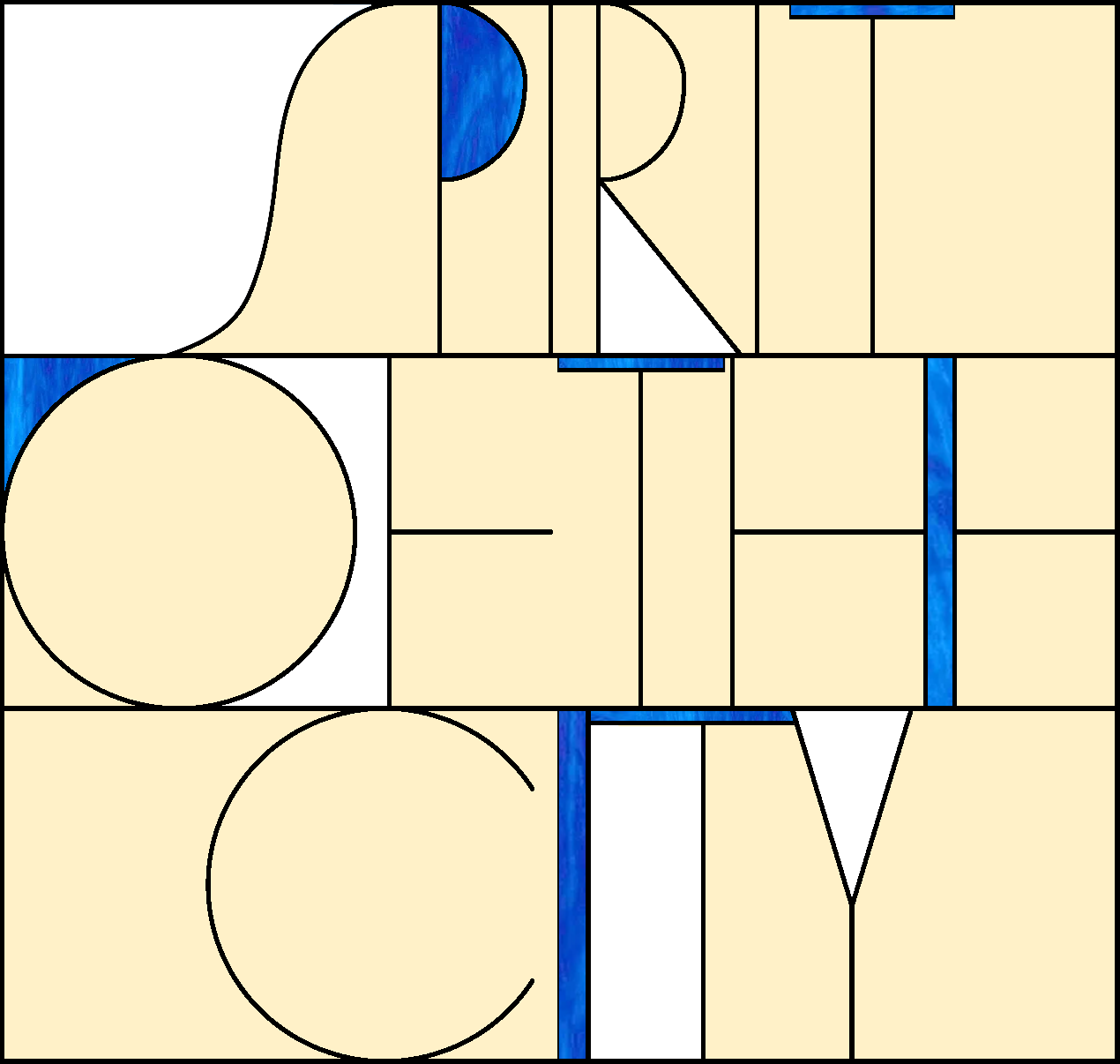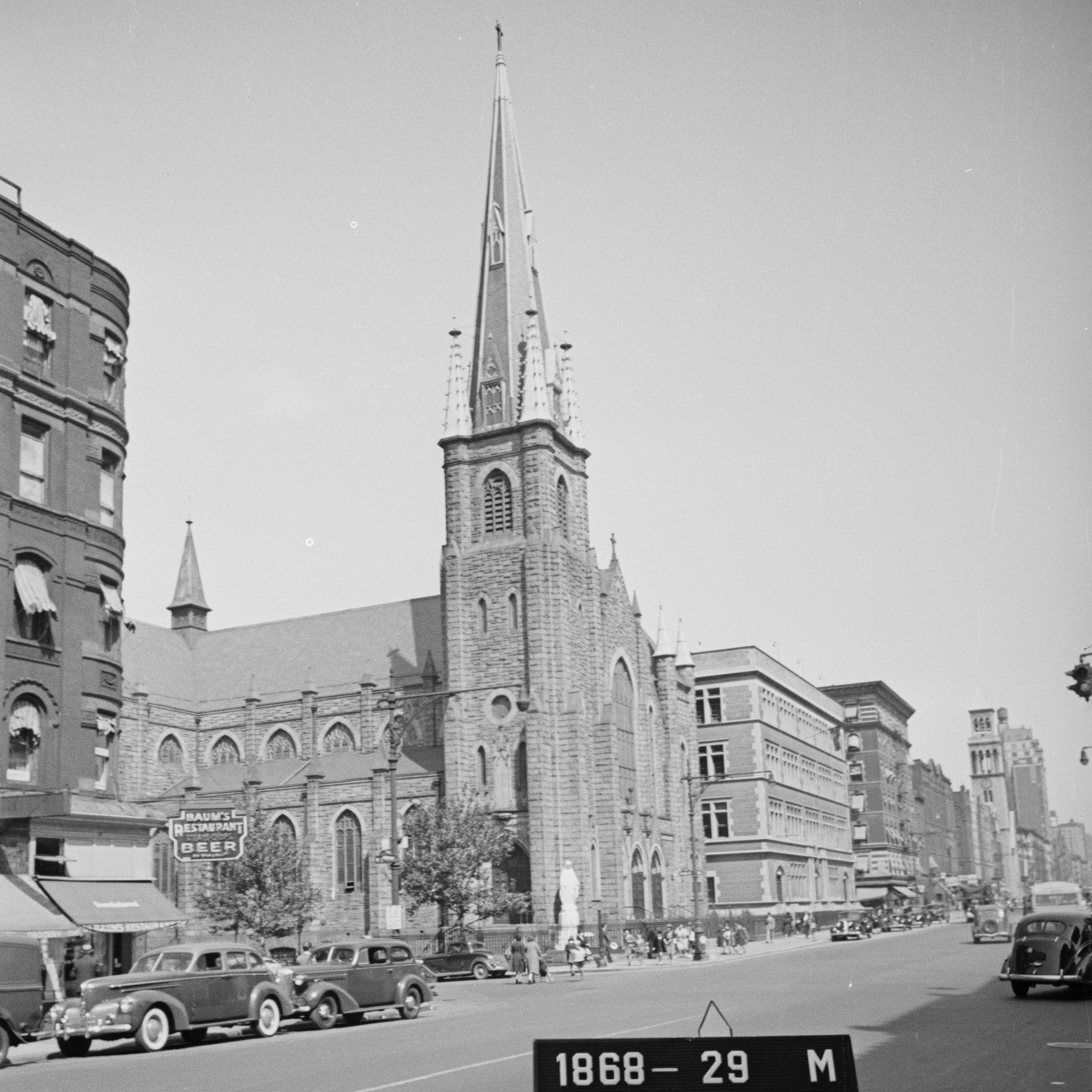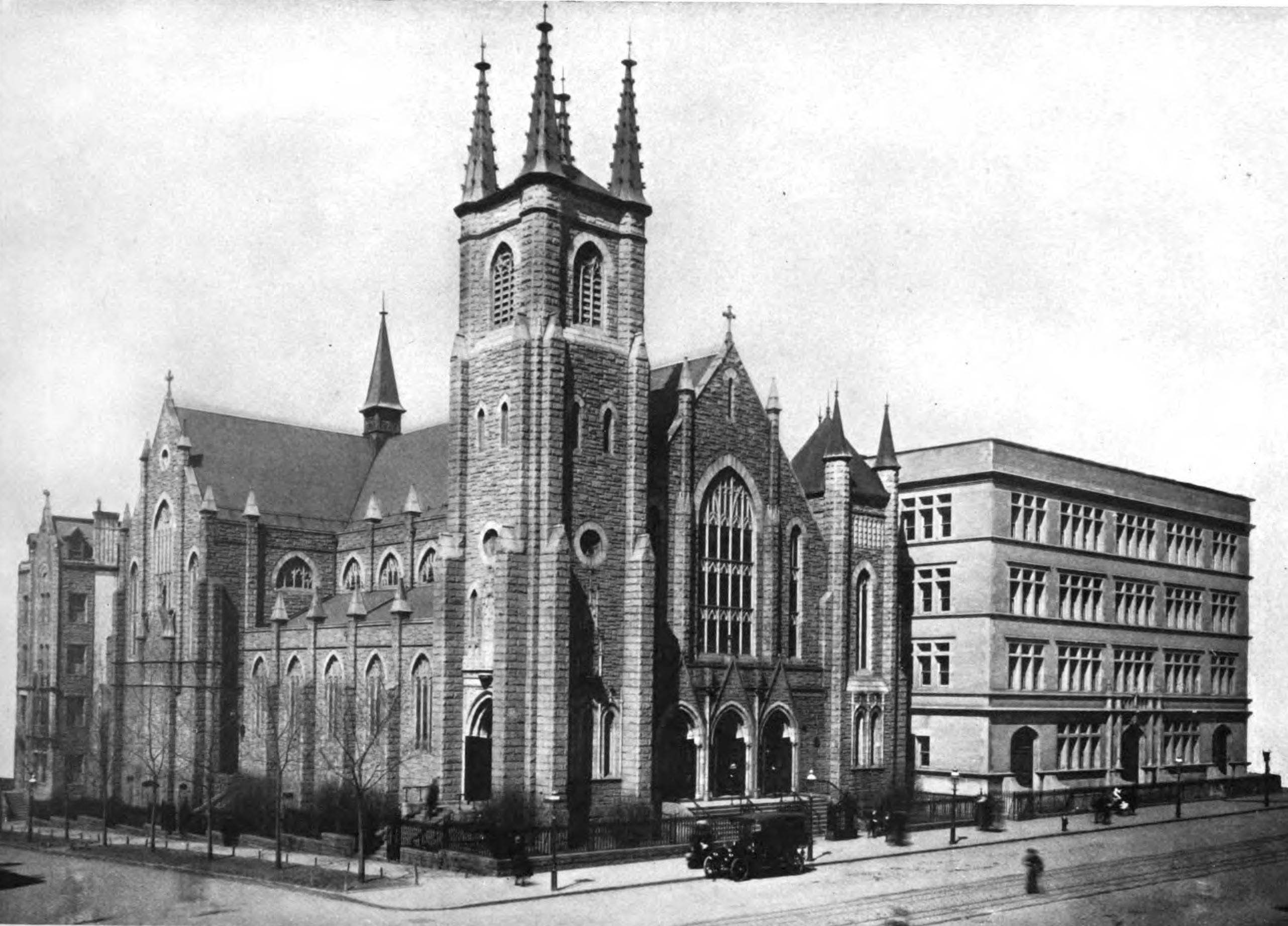207 West 96th Street

Church of the Holy Name of Jesus
207 West 96th Street
by Tom Miller
An Upper West Side staple
According to the 1914 book The Catholic Church in the United States of America, “In 1867, the West Side above 75th Street was a region of vacant lots, with here and there a suburban cottage, while the majority of the inhabitants were squatters who supported themselves by tilling small pieces of ground around their huts.” Be that as it may, there were growing numbers of Roman Catholics living in the district around the Bloomingdale Road and what would become the West 90s; and that year Archbishop John McCloskey approved the formation of the parish of the Holy Name of Jesus and sent the Rev. Richard Brennen north as its pastor.
Within a few months, the land extending along the block from what would become Broadway to Amsterdam Avenue on the north side of 97th Street was purchased for $11,250. Construction immediately began on a church. On August 9, 1868, the Archbishop celebrated the first mass in the wooden structure. The parish had spent a little over $50,000 in today’s dollars on the modest church.
When Rev. James M. Galligan took over as pastor on July 20, 1875, the nation was still reeling under the Financial Panic of 1873–the devastating economic collapse which would be known as the Great Depression until the Stock Market crash of 1929. The Catholic Church in the United States of America recalled that “a large debt burdened the parish.” Nevertheless, as The New York Times explained years later, “Father Galligan when he took charge at once set to work to build up his parish. He worked enthusiastically. He made his flock enthusiastic, and the parish began to grow rapidly.”
The Irish-born Rev. Galligan had come from the parish of the Church of the Holy Innocents, whose striking structure on West 37th Street had been completed just five years earlier. The Times noted that his new church “was a little frame building that was too small for the congregation,” and “coming as he did from a large and well-equipped parish…to a small and poorly equipped charge, he at times felt discouraged, but never once did he falter.” If Rev. Galligan intended to replace the building with a new one, he first had to somehow pay off the parish’s crushing debt. Collections and bazaars were held to raise funds, but in the fall of 1886, a plague of burglaries threatened progress.
On January 23, 1887, The New York Times reported that for the fourth time in six months’ thieves had broken into the church and “with a ‘jimmy,’ broke open the four poor boxes and the collection box.” But this time the church was one step ahead of them. The boxes had already been emptied. “The sacred vessels had also been removed, so that when the thieves broke open the tabernacles on the three altars they had their trouble for their pains. They forced open the baptismal font, which they doubtless supposed contained money or valuables, and tore a brass chain from a censor, which they probably supposed was gold.”
Finally, on November 23, 1889, 14 years after arriving Rev. Galligan became pastor, the Real Estate Record & Builders’ Guide reported on his ambitious project. “Thos. H. Poole has been selected as the architect for the church, chapel, and sisters’ home to be built by the Church of the Holy Name of Jesus, on the west side of 10th avenue, 96th and 97th streets…The church is to be Gothic and will have two spires.”
On August 9, 1868, the Archbishop celebrated the first mass in the wooden structure. The parish had spent a little over $50,000 in today’s dollars on the modest church.
From wood to pink Milford granite – building the new edifice
The 29-year-old English-born architect Thomas H. Pool had only been listed in city directories for a few years. This would be one of his earliest commissions, and he would go on to design numerous Roman Catholic churches and schools throughout the New York City area.
But at a time when substantial structures in New York City were being completed within 12 months or so, construction of the church building would be a long haul. On March 20, 1892, the “lower church” was dedicated. The parish could now worship in a portion of the basement while construction went on around them. Six years later, on January 29, 1898, The Record & Guide announced “The basement is completed, and has been used for the church purposes for some time. Work on the superstructure will be commenced in the spring.” Archbishop Michael Corrigan laid the cornerstone on April 17, 1898, and almost exactly two years later, on April 1, 1900, the completed church was dedicated.
Poole had created a strapping English Gothic structure faced in rough-cut pink Milford granite. The bell tower which anchored the southern corner featured thin buttresses and four Gothic finials. Crowning the traditional cruciform shape was a copper-clad fleche.
Archbishop Corrigan was back on April 1, 1900, to dedicate the new church which could seat 1,400 worshipers. The New-York Tribune commented on the interior decorations, saying that the Gothic-style altars were “constructed of statuary marble and rare Mexican onyx. The main altar has three spires, the center of which, surmounted by a marble cross, rises to a lofty height, and is flanked by two wing spires.” The high altar featured Da Vinci’s Last Supper carved in high relief. The article described the richly carved tabernacle as being “shrouded by a heavily groined hanging canopy which also supports the statuary niche, which in turn is roofed by the main canopy.”
At a time when electric power was not always dependable, the “combination chandelier of gas and electricity” provided a built-in contingency. “The side altars are in keeping with the same style of architecture, with ornate mensa and reredos and statue niche, roofed over by a groined canopy and supporting a tower spire of delicate outline,” said the article.
The pamphlet distributed among the parishioners that day reflected the tireless work the pastor had put into the project. “The Church of the Holy Name is a grand and lasting monument to Father Gallagan’s efforts, and in its general construction, in its design, and in its beautiful appointments it reflects rare good taste, fine discrimination, and sound judgment.”
He would not enjoy the fruits of his perseverance for long. A year later almost to the day, on April 3, 1901, Rev. James M. Galligan died. In reporting on his death The New York Times noted “The principal work of Father Gilligan [sic] and one by which he will be longest remembered, is the new Church of the Holy Name, in the erection and equipping of which he was the dominant spirit.”
A History of Activity
The church would be, of course, the scene of many notable weddings and funerals. But the funeral of Fire Commissioner Hugh Bonner on March 17, 1908, was remarkable. The New-York Tribune reported, “The church was so crowded that lines of police had to be formed around the street, where hundreds had gathered to take part in the services.” The cortege left the Bonner home on West End Avenue at 9:30, led by three battalions of firefighters, mounted police, and the police band. Twelve fire companies followed, along with a battalion of Brooklyn firefighters and two others led by three Deputy Fire Chiefs who had served under Bonner.
As the parish’s golden jubilee approached, a change in Poole’s design was made. A steeple was added to the bell tower just in time for the celebration on May 30, 1918. It was somewhat symbolic of the coming together of several events. With the end of World War I, President Woodrow Wilson had set aside that day as a “day of public humiliation, prayer, and fasting” (more popularly called the Day of Prayer). And not only was the parish 50 years old, it was finally out of debt, which meant that the church building could be consecrated as part of the ceremonies. The New York Times reported, “The streets near the church were decorated in honor of the jubilee and bore a holiday air.”
1918 was also a significant year for a former parishioner. Among the members in 1894 was the Thomas Donahue family, who had just relocated to 791 Amsterdam Avenue. Donahue was born in Ireland and his wife, Dorothy Rentz was German. The couple would have ten children, one of whom, Stephen Joseph, was one-year-old when they moved into the parish. Stephen would pursue a religious vocation and after studying in Rome for five years, was ordained by Cardinal Pompili, Vicar of Rome, on May 22, 1918. His rise in the New York Church would be meteoric. In 1920 he became assistant secretary to Cardinal Patrick Joseph Hayes and was promoted to secretary a year later. He traveled extensively with the Cardinal, including several trips to Rome.
He was created a monsignor in 1924. In September 1932 he returned to the Church of the Holy Name of Jesus as pastor following the death of Monsignor James B. Curry. Then, on March 2, 1934, Cardinal Hayes announced that Pope Pius XI had personally selected Donahue to be elevated to Bishop. In a ceremony which The New York Times described as “marked by ancient splendor,” Donahue, just barely 40 years old, was created a bishop on May 1. The newspaper estimated the crowd in St. Patrick’s Cathedral to be around 5,000. The three-hour service was attended by four Archbishops and 48 Bishops along with several hundred priests.
On March 20, 1892, the “lower church” was dedicated. The parish could now worship in a portion of the basement while construction went on around them.
Auxiliary Bishop Donahue remained pastor of the Church of the Holy Name of Jesus. He officiated at its re-dedication on December 8, 1937, at which time it was noted that the “interior of the church has been completed redecorated.”
Among Donahue’s most passionate concerns was the motion picture industry. He was a member of the Motion Picture Committee of the National Catholic Welfare Council, a member of the Motion Picture Committee of the American Council of Bishops, and was involved in the Legion of Decency. The Legion of Decency, organized by the Catholic Church, was “devoted to the cause of morality in motion pictures.”
Bishop Donahue resigned in May 1972. He died in the Catholic-run Mary Manning Walsh Home on York Avenue at the age of 88 in August 1982.
In the meantime, the parish of the Holy Name of Jesus had substantially changed. Urban renewal projects had resulted in the demolition of entire blocks of rowhouses to make way for tenement projects. As the parish welcomed new immigrants from places like Haiti, the Dominican Republic, and Puerto Rico, the liturgies adapted. Masses are now celebrated in French, English, and Spanish.
Through it all the stately edifice is essentially unchanged since the steeple changed Thomas Poole’s English Gothic design in 1918.
Tom Miller is a social historian and blogger at daytoninmanhattan.blogspot.com



